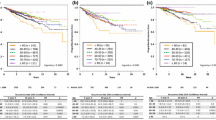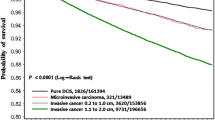Abstract
We divided 324 cases with invasive ductal breast carcinoma into three age groups, and investigated the differences in proliferative activity and extension of the intraductal components among the age cohorts. Proliferative activity was expressed as the number of MIB 1-positive nuclei per 1000 cancer cells in the intraductal components (MLI), and the intraductal component extension farthest from the invasive focus was defined as the maximum distance of ductal spread (MXDS). Moreover, analyses were conducted for three grade types, classified according to the classification system of ductal carcinoma in situ. The under-40 age group had significantly higher MXDS values than the other two age groups (p = 0.0280), and this trend was more marked in those with the non-high grade without necrosis type (p = 0.0045). The under-40 age group had higher MLIs, but the differences did not reach statistical significance (p = 0.0793). In regard to those with the high grade type, the under-40 age group had significantly higher MLIs than the other two age groups (p = 0.0269), and this trend was not significant in the cases with any other grade types. Associations between the age group and the margin status of the lumpectomy specimens were investigated in the 143 cases in which breast conserving surgery was tried. The under-40s had a significantly higher margin-positive rate in their lumpectomy specimens than the other two age groups (p = 0.0362), and this trend was also seen in the groups with the non-high grade without necrosis type (p = 0.0256). These results confirm the importance of considering patient age when designing surgical procedures for breast conserving therapy.
Similar content being viewed by others
References
Schnitt SJ, Connolly JL, Harris JR, Hellman S, Cohen RB: Pathologic predictors of early local recurrence in stage I and II breast cancer treated by primary radiation therapy. Cancer 53: 1049–1053, 1984
Recht A, Connolly JL, Schnitt SJ, Silver B, Rose MA, Love S, Harris JR: The effect of young age on tumor recurrence in the treated breast after conservative surgery and radiotherapy. Int J Rad Oncol Biol Phys 14: 3–10, 1988
Bartelink H, Borger JH, van Dongen JA, Peterse JL: The impact of tumor size and histology on local control after breast-conserving therapy. Radiother Oncol 11: 297–303, 1988
Kurtz JM, Jacqemier J, Amalric R, Brandone H, Ayme Y, Hans D, Bressac C, Roth J, Spitalier J-M: Risk factors for breast recurrence in premenopausal and postmenopausal patients with ductal cancers treated by conservative therapy. Cancer 65: 1867–1878, 1990
Boyages J, Recht A, Connolly JL, Schnitt SJ, Gelman R, Kooy H, Love S, Osteen RT, Cady B, Silver B, Harris JR: Early breast cancer: predictors of breast recurrence for patients treated with conservative surgery and radiation therapy. Radiother Oncol 19: 29–41, 1990
Jacqemier J, Kurtz JM, Amalric R, Brandone H, Ayme Y, Spitalier J-M: An assessment of extensive intraductal component as a risk factor for local recurrence after breast-conserving therapy. Br J Cancer 61: 873–876, 1990
Vicini FA, Everlein TJ, Connoly JL, Recht A, Abner A, Schnitt SJ, Silen W, Harris JR: The optimal extent of resection for patients with stage I or II breast cancer treated with conservative surgery and radiotherapy. Ann Surg 214: 200-205, 1991
Veronesi U, Luini A, del Vecchio M, Greco M, Galimberti V, Merson M, Rilke F, Sacchini V, Saccozzi R, Savio T, Zucali R, Zurrida S, Salvadori B: Radiotherapy after breast-preserving surgery in women with localized cancer of the breast. N Engl J Med 328: 1587–1591, 1993
Lee CG, McCormick B, Mazumdar M, Vetto J, Borgen PI: Infiltrating breast carcinoma in patients age 30 years and younger: long term outcome for life, relapse, and second primary tumors. Int J Rad Oncol Biol Phys 23: 969–975, 1992
Fisher ER, Anderson S, Redmond C, Fisher B: Ipsilateral breast tumor recurrence and survival following lumpectomy and irradiation: pathological findings from NSABP protocol B-06. Semi Surg Oncol 8: 161–166, 1992
Borger J, Kemperman H, Hart A, Peterse H, von Dongen J, Bartelink H: Risk factors in breast-conservation therapy. J Clin Oncol 12: 653–660, 1994
Nixon AJ, Neuberg D, Hayes DF, Gelman R, Connoly JL, Schnitt S, Abner A, Recht A, Vicini F, Harris JR: Relationship of patient age to pathologic features of the tumor and prognosis for patients with stage I or II breast cancer. J Clin Oncol 12: 888–894, 1994
Smitt MC, Nowels KW, Zdeblick MJ, Jeffery S, Carlson RW, Stockdale FE, Goffinet DR: The importance of the lumpectomy surgical margin status in long term results of breast conservation. Cancer 76: 259–267, 1995
Dewar JA, Arriagada R, Benhamou S, Behamou E, Bretel J-J, Pellae-Cosset B, Marin J-L, Petit J-Y, Contesso G, Sarrazin D: Local relapse and contralateral tumor rates in patients with breast cancer treated with conservative surgery and radiotherapy (Institute Gustave Roussay 1970-1982). Cancer 76: 2260–2265, 1995
Fisher CJ, Egan MK, Smith P, Wicks K, Millis RR, Fentiman IS: Histopathology of breast cancer in relation to age. Br J Cancer 75: 593–596, 1997
Fortin A, Larochelle M, Laverdiére J, Lavertu S, Tremblay D: Local failure is responsible for the decrease in survival for patients with breast cancer treated with conservative surgery and postoperative radiotherapy. J Clin Oncol 17: 101–109, 1999
Fourquet A, Campana F, Zafrani B, Mosseri V, Vielh P, Durand J-C, Vilcoq JR: Prognostic factors of breast recurrence in the conservative management of early breast cancer: A 25-year follow-up. Int J Rad Oncol Biol Phys 17: 719–725, 1989
Elkhuizen PHM, van de Vijver MJ, Hermans J, Zonderland HM, van de Velde CJH, Leer J-WH: Local recurrence after breast-conserving therapy for invasive breast cancer: high incidence in young patients and association with poor survival. Int J Rad Oncol Biol Phys 40: 859–867, 1998
Elston CW, Ellis IO: Pathologic prognostic factors in breast cancer.1. The value of histological grade in breast cancer: experience from a large study with long-term follow-up. Histopathology 19: 403–410, 1991
Douglas-Jones AG., Gupta SK, Attanoos RL, Morgan JM, Mansel RE: A critical appraisal of six modern classification of ductal carcinoma in situ of the breast (DCIS): correlation with grade of associated invasive carcinoma. Histopathology 29: 397–409, 1996
Silverstein ML, Lagios MD, Craig PH, Waisman JR, Lewinsky BS, Colburn WJ, Poller DN: A prognostic index for ductal carcinoma in situ of the breast. Cancer 77: 2267–2274, 1996
Silverstein ML, Poller DN, Waisman JR, Colburn WJ, Barth A, Gierson ED, Lewinsky B, Gamagami P, Slamon DJ: Prognostic classification of breast ductal carcinoma-in situ. Lancet 345: 1154-1157, 1995
Ribeiro GG, Swidell R: The prognosis of breast carcinoma in women aged less than 40 years. Clin Radiol 32: 231–236, 1981
Rutqvist LE, Wallgren A: Influence of age on outcome in breast carcinoma. Acta Radiol Oncol 22: 289–294, 1983
Mueller CB, Ames F, Anderson GD: Breast cancer in 3,558 women: Age as a significant determinant in the rate of dying and causes of death. Surgery 83: 123–132, 1978
Stoll BA: Does the malignancy of breast cancer vary with age? Clin Oncol 2: 73–80, 1976
Chung M, Chang HR, Bland KI, Wanebo H: Younger women with breast carcinoma have a poorer prognosis than older women. Cancer 77: 97–103, 1996
Kurtz JM, Jacqemier J, Amalric R, Brandone H, Ayme Y, Hans D, Bressac C, Spitalier JM: Why are local recurrences after breast-conserving therapy more frequent in younger patients? J Clin Oncol 8: 591–598, 1990
van Dongen JA, Fentiman IS, Harris JR, Holland R, Peterse JL, Salvadori B, Stewart HJ: In situ breast cancer: the EORTC consensus meeting. Lancet 25–27, 1989
Vicini F, Recht A, Abner A, Silver B, Harris JR: The association between very young age and recurrence in the breast in patients treated with conservative surgery and radiation therapy [abstract]. Int J Rad Oncol Biol Phys 19: 132, 1990
Ohtake T, Abe R, Kimijima I, Fukushima T, Tsuchiya A, Hoshi K, Wakasa H: Intraductal extension of primary invasive breast carcinoma treated by breast-conservative surgery computer graphic three-dimensional reconstruction of the mammary duct-lobular system. Cancer 76: 32–45, 1995
Querzoli P, Albonico G, Ferretti S, Rinaldi R, Magri E, Indelli M, Nenci I: MIB-1 proliferative activity in invasive breast cancer measured by image analysis. J Clin Pathol 49: 926–930, 1996
Peer PGM, van Dijck JAAM, Hendriks JHCL, Holland R, Verbeek ALM: Age-dependent growth risk of primary breast cancer. Cancer 71: 3547–3551, 1993
Stewart JA, Foster RS: Breast cancer and Aging. Semi Oncol 16: 41–50, 1989
Mourad WA, Setrakian S, Hales ML, Abdulla M, Trucco G: The argyrophilic nucleolar organizer regions in ductal carcinoma in situ of the breast. Cancer 74: 1739–1745, 1994
Imamura H, Haga S, Shimizu T, Watanabe O, Kajiwara T, Aiba M: Prognostic significance of MIB1-determined proliferative activities in intraductal components and invasive foci associated with invasive ductal breast carcinoma. Br J Cancer 79: 179–178, 1999
Rights and permissions
About this article
Cite this article
Imamura, H., Haga, S., Shimizu, T. et al. Relationship between the morphological and biological characteristics of intraductal components accompanying invasive ductal breast carcinoma and patient age. Breast Cancer Res Treat 62, 177–184 (2000). https://doi.org/10.1023/A:1006462328544
Issue Date:
DOI: https://doi.org/10.1023/A:1006462328544




